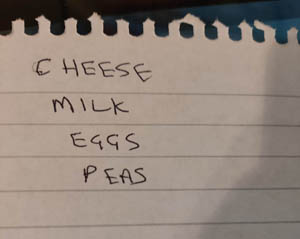2. Storing Data
Information needs to be organised so that the data can be accessed as efficiently as possible.
For example, a paper shopping list is an organised collection of items (data) with the sole purpose of recording what you want to buy on your shopping trip.
Setting it down on paper is a form of data storage to avoid having to remember it in your head.
The very simplest example is just a list of individual generic items: cheese, milk, eggs, peas.

A slightly more detailed shopping list might include the quantity needed:
500g cheese, 1 pint milk, 6 eggs, 1 pack peas.
This list has two main categories of data, namely quantity needed and its generic name. Let’s expand it even more to include specific type or brand name of each item.
And to make it a bit more organised, each shopping item is on a separate line and its details have a comma to separate each part of the information
- 500g, Stilton, Cheese
- 1 pint, Skimmed, Milk
- 1 pack, garden, peas
Challenge see if you can find out one extra fact on this topic that we haven't already told you
Click on this link: Pros and cons of online anonymity
